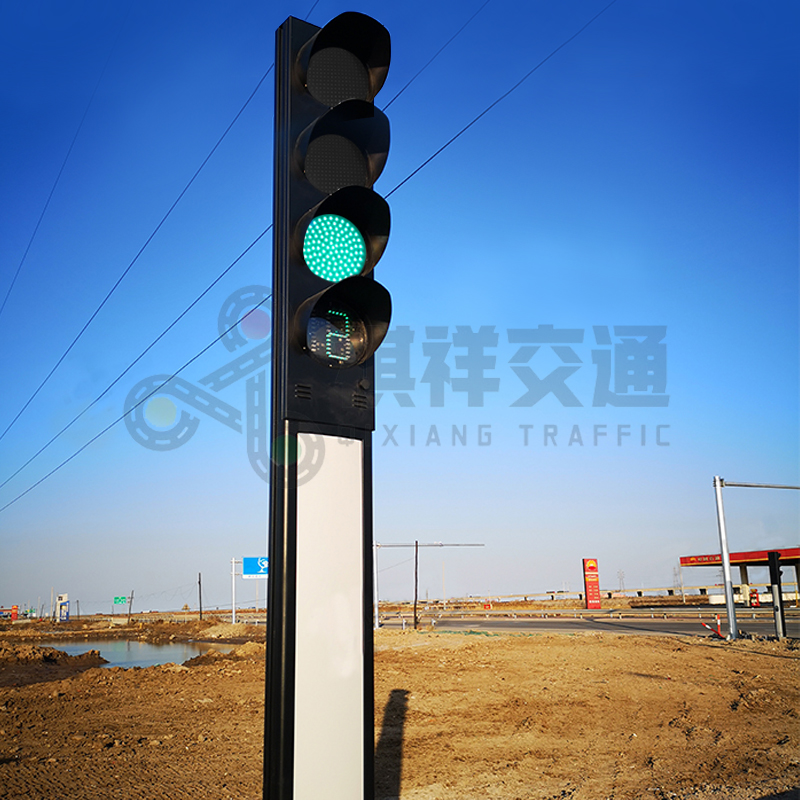In urban planning and traffic management, the safety and efficiency of pedestrian crossings are of paramount importance. One of the most important advancements in this area is integrated pedestrian traffic lights. Not only do these lights improve pedestrian visibility, they also streamline traffic flow, making urban environments safer and more traffic-friendly. Traffic light supplier Qixiang takes an in-depth look at the features, benefits and considerations of integrated pedestrian traffic lights, with a particular focus on their 3.5 and 4.5 meter heights.
Learn about integrated pedestrian traffic lights
Integrated pedestrian traffic lights are designed to provide clear signals to pedestrians and drivers. Unlike traditional traffic lights, which often require separate pedestrian signals, integrated systems combine these functions into a single unit. This integration helps reduce confusion at intersections and makes it easier for pedestrians to understand when it is safe to cross.
These lights usually feature bright LED displays that are easily visible from a distance, even in adverse weather conditions. Integrating sound signals for visually impaired pedestrians further enhances its usefulness, ensuring that everyone can navigate urban spaces safely.
Height precautions: 3.5m and 4.5m
One of the key factors in designing an integrated pedestrian traffic light is its height. The standard heights of 3.5 and 4.5 meters were chosen based on various factors, including visibility, urban density and the specific needs of the area.
1. Height 3.5 meters:
Urban Environment: In densely populated urban areas, a height of 3.5 meters is usually sufficient. This height allows the lights to be visible to pedestrians and drivers without blocking the view of surrounding buildings or other traffic signals.
Pedestrian Visibility: At this height, pedestrians can easily see the lights, ensuring they can quickly identify when it is safe to cross. This is especially important in high-traffic areas, where quick decision-making is critical for safety.
Cost Effectiveness: Lower installations can also be more cost effective, requiring less materials and potentially reducing installation and maintenance costs.
2. Height 4.5 meters:
Highway: In contrast, a height of 4.5 meters is typically used in areas where vehicle speeds are higher. The increased height ensures that the lights are visible from greater distances, giving the driver ample time to react to the signal.
Obstacle Clearance: Taller lights can also help avoid obstacles such as trees, buildings, or other structures that may block visibility. This is especially important in suburban or rural areas where the landscape changes a lot.
Enhanced Visibility: The extra height helps ensure the light can be seen even in adverse weather conditions, such as heavy rain or fog, where lower lights may be obscured.
Benefits of Integrated Pedestrian Traffic Lights
The implementation of integrated pedestrian traffic lights, regardless of their height, has many benefits:
Improved Safety: By clearly signaling when it is safe to cross, these lights can significantly reduce the risk of accidents at crosswalks. The integration of sound signals further assists those with visual impairments, promoting inclusivity.
Simplified Traffic Flow: Integrated systems help manage pedestrian and vehicular flow more efficiently. By providing clear signals, they reduce confusion and the likelihood of accidents, making traffic flow more smoothly.
Aesthetics: The stylish design of integrated pedestrian traffic lights helps enhance the overall aesthetics of the urban environment. By reducing visual clutter, they create a more organized and attractive streetscape.
Technology Integration: Many modern integrated pedestrian traffic lights are equipped with smart technology that can monitor and adjust in real time based on traffic conditions. This adaptability can further improve safety and efficiency.
In conclusion
As cities continue to grow and develop, the need for effective pedestrian traffic management becomes increasingly important. Integrated pedestrian traffic lights, especially those with a height of 3.5 meters and 4.5 meters, represent an important step forward in ensuring safety and efficiency at urban intersections. By understanding the impacts and benefits of integration, city planners and transportation authorities can make informed decisions that improve safety and quality of life for all city residents.
In summary, the future of urban transportation lies in the thoughtful fusion of technology and design, and integrated pedestrian traffic lights are at the forefront of this development. As cities continue to innovate, these systems will play a vital role in shaping urban environments that are safer and more accessible for everyone.
Post time: Nov-08-2024







